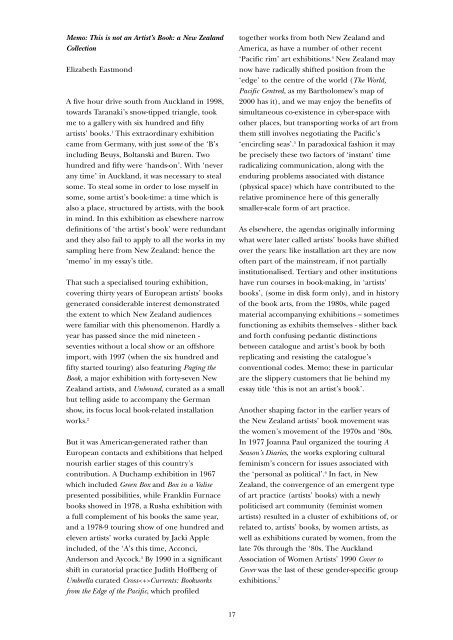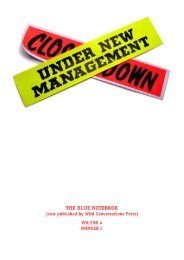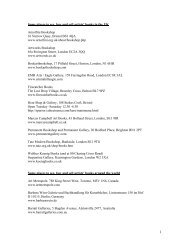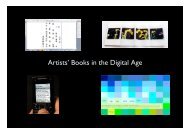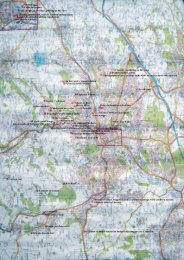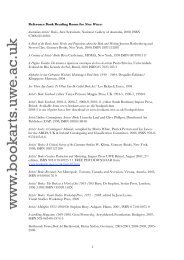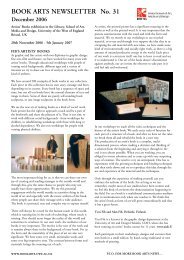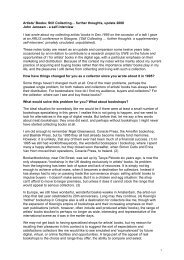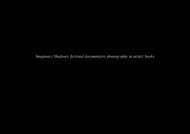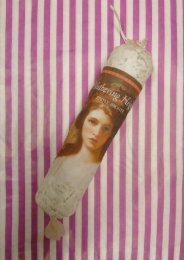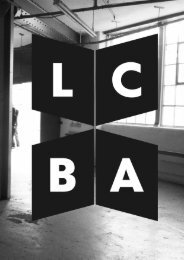Artist's Book Yearbook 2003-2005 - Book Arts - University of the ...
Artist's Book Yearbook 2003-2005 - Book Arts - University of the ...
Artist's Book Yearbook 2003-2005 - Book Arts - University of the ...
Create successful ePaper yourself
Turn your PDF publications into a flip-book with our unique Google optimized e-Paper software.
Memo: This is not an Artist’s <strong>Book</strong>: a New Zealand<br />
Collection<br />
Elizabeth Eastmond<br />
A five hour drive south from Auckland in 1998,<br />
towards Taranaki’s snow-tipped triangle, took<br />
me to a gallery with six hundred and fifty<br />
artists’ books. 1 This extraordinary exhibition<br />
came from Germany, with just some <strong>of</strong> <strong>the</strong> ‘B’s<br />
including Beuys, Boltanski and Buren. Two<br />
hundred and fifty were ‘hands-on’. With ‘never<br />
any time’ in Auckland, it was necessary to steal<br />
some. To steal some in order to lose myself in<br />
some, some artist’s book-time: a time which is<br />
also a place, structured by artists, with <strong>the</strong> book<br />
in mind. In this exhibition as elsewhere narrow<br />
definitions <strong>of</strong> ‘<strong>the</strong> artist’s book’ were redundant<br />
and <strong>the</strong>y also fail to apply to all <strong>the</strong> works in my<br />
sampling here from New Zealand: hence <strong>the</strong><br />
‘memo’ in my essay’s title.<br />
That such a specialised touring exhibition,<br />
covering thirty years <strong>of</strong> European artists’ books<br />
generated considerable interest demonstrated<br />
<strong>the</strong> extent to which New Zealand audiences<br />
were familiar with this phenomenon. Hardly a<br />
year has passed since <strong>the</strong> mid nineteen -<br />
seventies without a local show or an <strong>of</strong>fshore<br />
import, with 1997 (when <strong>the</strong> six hundred and<br />
fifty started touring) also featuring Paging <strong>the</strong><br />
<strong>Book</strong>, a major exhibition with forty-seven New<br />
Zealand artists, and Unbound, curated as a small<br />
but telling aside to accompany <strong>the</strong> German<br />
show, its focus local book-related installation<br />
works. 2<br />
But it was American-generated ra<strong>the</strong>r than<br />
European contacts and exhibitions that helped<br />
nourish earlier stages <strong>of</strong> this country’s<br />
contribution. A Duchamp exhibition in 1967<br />
which included Green Box and Box in a Valise<br />
presented possibilities, while Franklin Furnace<br />
books showed in 1978, a Rusha exhibition with<br />
a full complement <strong>of</strong> his books <strong>the</strong> same year,<br />
and a 1978-9 touring show <strong>of</strong> one hundred and<br />
eleven artists’ works curated by Jacki Apple<br />
included, <strong>of</strong> <strong>the</strong> ‘A’s this time, Acconci,<br />
Anderson and Aycock. 3 By 1990 in a significant<br />
shift in curatorial practice Judith H<strong>of</strong>fberg <strong>of</strong><br />
Umbrella curated CrossCurrents: <strong>Book</strong>works<br />
from <strong>the</strong> Edge <strong>of</strong> <strong>the</strong> Pacific, which pr<strong>of</strong>iled<br />
17<br />
toge<strong>the</strong>r works from both New Zealand and<br />
America, as have a number <strong>of</strong> o<strong>the</strong>r recent<br />
‘Pacific rim’ art exhibitions. 4 New Zealand may<br />
now have radically shifted position from <strong>the</strong><br />
‘edge’ to <strong>the</strong> centre <strong>of</strong> <strong>the</strong> world (The World,<br />
Pacific Centred, as my Bartholomew’s map <strong>of</strong><br />
2000 has it), and we may enjoy <strong>the</strong> benefits <strong>of</strong><br />
simultaneous co-existence in cyber-space with<br />
o<strong>the</strong>r places, but transporting works <strong>of</strong> art from<br />
<strong>the</strong>m still involves negotiating <strong>the</strong> Pacific’s<br />
‘encircling seas’. 5 In paradoxical fashion it may<br />
be precisely <strong>the</strong>se two factors <strong>of</strong> ‘instant’ time<br />
radicalizing communication, along with <strong>the</strong><br />
enduring problems associated with distance<br />
(physical space) which have contributed to <strong>the</strong><br />
relative prominence here <strong>of</strong> this generally<br />
smaller-scale form <strong>of</strong> art practice.<br />
As elsewhere, <strong>the</strong> agendas originally informing<br />
what were later called artists’ books have shifted<br />
over <strong>the</strong> years: like installation art <strong>the</strong>y are now<br />
<strong>of</strong>ten part <strong>of</strong> <strong>the</strong> mainstream, if not partially<br />
institutionalised. Tertiary and o<strong>the</strong>r institutions<br />
have run courses in book-making, in ‘artists’<br />
books’, (some in disk form only), and in history<br />
<strong>of</strong> <strong>the</strong> book arts, from <strong>the</strong> 1980s, while paged<br />
material accompanying exhibitions – sometimes<br />
functioning as exhibits <strong>the</strong>mselves - sli<strong>the</strong>r back<br />
and forth confusing pedantic distinctions<br />
between catalogue and artist’s book by both<br />
replicating and resisting <strong>the</strong> catalogue’s<br />
conventional codes. Memo: <strong>the</strong>se in particular<br />
are <strong>the</strong> slippery customers that lie behind my<br />
essay title ‘this is not an artist’s book’.<br />
Ano<strong>the</strong>r shaping factor in <strong>the</strong> earlier years <strong>of</strong><br />
<strong>the</strong> New Zealand artists’ book movement was<br />
<strong>the</strong> women’s movement <strong>of</strong> <strong>the</strong> 1970s and ‘80s.<br />
In 1977 Joanna Paul organized <strong>the</strong> touring A<br />
Season’s Diaries, <strong>the</strong> works exploring cultural<br />
feminism’s concern for issues associated with<br />
<strong>the</strong> ‘personal as political’. 6 In fact, in New<br />
Zealand, <strong>the</strong> convergence <strong>of</strong> an emergent type<br />
<strong>of</strong> art practice (artists’ books) with a newly<br />
politicised art community (feminist women<br />
artists) resulted in a cluster <strong>of</strong> exhibitions <strong>of</strong>, or<br />
related to, artists’ books, by women artists, as<br />
well as exhibitions curated by women, from <strong>the</strong><br />
late 70s through <strong>the</strong> ‘80s. The Auckland<br />
Association <strong>of</strong> Women Artists’ 1990 Cover to<br />
Cover was <strong>the</strong> last <strong>of</strong> <strong>the</strong>se gender-specific group<br />
exhibitions. 7


